| Columns Retired Columns & Blogs |
Bix would be flattered to know he has a transducer in his likeness!
http://www.outerspace-software.com/alphabix.html
My estimate of the Vivid B1's voltage sensitivity was a little lower than specified, at 87dB(B)/2.83V/m, which is about average. The speaker is specified as being a 4 ohm load, presumably because, as can be seen in fig.1, the impedance drops to a minimum of 3 ohms in the low midrange and remains below 6 ohms for most of the region below 700Hz. However, the high impedance in the treble compared with the midrange will shelve the speaker's high frequencies up if it is used with a tube amplifier possessing a high source impedance, as most of them do.
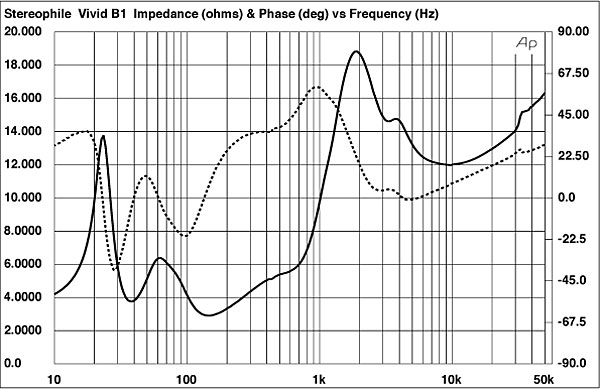
There is a very small discontinuity in the impedance traces between 400 and 500Hz; investigating the enclosure's vibrational behavior with a plastic-tape accelerometer uncovered a fairly strong resonant mode at 430Hz (fig.2). Fortunately, this is of both high Quality Factor (Q) and relatively high frequency, which will work against its having audible consequences. Even with a stethoscope, I couldn't hear this mode while playing the half-step–spaced toneburst track on Editor's Choice (CD, Stereophile STPH016-2). Commendably, no other resonant modes are visible in this graph.
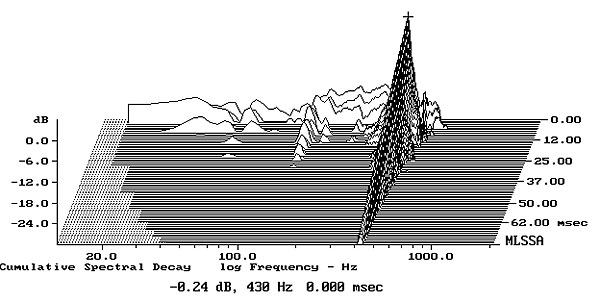
The saddle at 38Hz in the impedance-magnitude trace suggests that this is the tuning frequency of the twin ports, and both the front woofer (fig.3, blue trace) and rear woofer (green trace) have the expected minimum-motion notch in their nearfield responses at that frequency. The sum of the port outputs (red trace) peaks in the same region, again as expected. This graph also shows that the rear woofer starts to roll off above 150Hz, leaving the front woofer to extend to the crossover to the tweeter. However, because the two woofers are operating with the same polarity but their acoustic centers are physically separated by a distance of 14", their outputs will cancel in front of (or behind) the speaker when this distance is equivalent to a half-wavelength of the sound emitted. The complex sum of the woofers' nearfield outputs (fig.3, black trace) therefore suffers from a cancellation notch between 200 and 300Hz and the sum below that frequency is exaggerated, even allowing for the usual nearfield boost, a measurement artifact that results from the assumption that the drive-units are firing into half-space rather than a full sphere.

Higher in frequency in fig.3, the crossover between the woofers and the combined output of the midrange unit and tweeter lies just above the specified 900Hz, and the filters' acoustic slopes appear to be fourth-order, 24dB/octave. The B1's upper-frequency farfield output on the tweeter axis (brown trace) is extraordinarily flat; averaging the response across a 30° horizontal window doesn't change the picture (fig.4), implying wide and even lateral dispersion. A slight depression in the crossover region can be seen in this graph, with the midrange slightly boosted compared to the treble. Below 350Hz, this graph shows the complex sum of the outputs of the woofers and ports; again, the calculated cancellation suckout is evident. The speaker's output rolls off with the usual 24dB/octave slope below 40Hz.
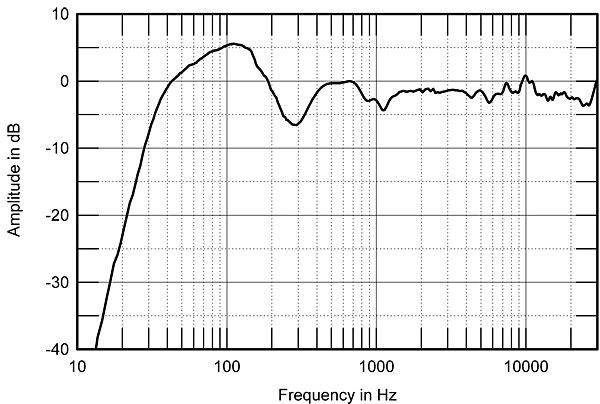
Fig.5 shows the B1's lateral dispersion, referenced to the response on the tweeter axis so that the changes are emphasized. This is textbook behavior above 1kHz, the speaker having a wide, even, well-controlled radiation pattern—something that correlates with stable, well-defined stereo imaging. Below 1kHz, the on-axis suckout due to the spaced woofers fills in to the speaker's sides, as expected. (They are the same distance from the microphone when it is placed 90° off axis, so there is no cancellation.) In the vertical plane (fig.6), the use of a fourth-order crossover means that there is virtually no change in response as the listener shifts vertical position within 10° above or below the tweeter axis, which is 39" from the floor. Listening to the B1, you can slouch in your chair without getting a degraded response!
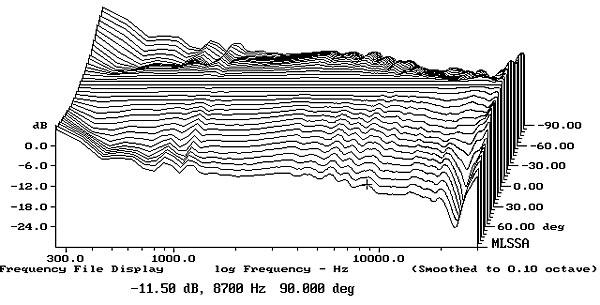

Predicting the in-room behavior of a speaker like the Vivid B1, with its spaced, same-polarity woofers, is impossible because, although the driver outputs cancel on axis in the lower midrange, the energy is still present somewhere in the room. Whether the lower midrange will be perceived as lacking in energy will therefore depend on the positions of the speakers in the room and the room's acoustics. Fig.7 shows the spatially averaged response of the B1s in my room (red trace) and in John Marks's room (blue trace). There is broad agreement in the traces above 500Hz, including the downward slope in the treble, due to the speaker's well-controlled dispersion and the increasing absorptivity of the room furnishings in the top octaves, and the excess of energy between 500 and 800Hz. Reference to other speakers I have measured in my room suggests that the B1's in-room balance is a little too generous in the highs, which is evident in this graph compared to the balance in JM's room, which is not quite as live as mine in the top octaves.
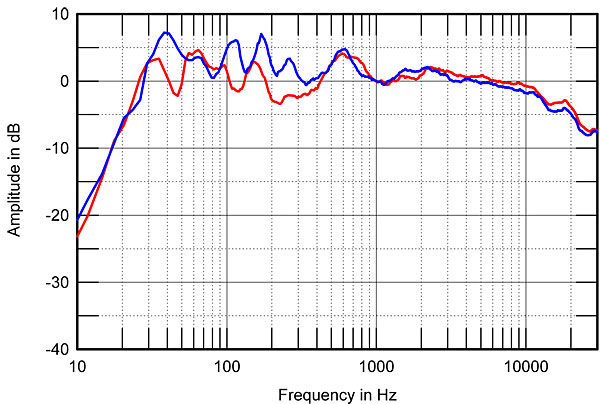
The differences between our rooms and the interactions of the speakers with those rooms does change the picture to a greater degree in the lower midrange and the bass. While the lower mids are a little suppressed in my room, there is actually too much energy in the same region in JM's room. The traces are both affected below 200Hz by room modes that have not been eliminated by the spatial averaging, but the Vivids' low-frequency output is more evenly balanced in my larger room. The B1's in-room response extends to 30Hz in both rooms, with the fast rolloff typical of a reflex design evident below that frequency.
Turning to the time domain, the B1's step response on its tweeter axis (fig.8) indicates that first to arrive at the microphone is the tweeter's output, followed by the midrange unit's, then the front woofer's, and then, about 1.5 milliseconds later, the rear woofer's. All four drive-units are connected with positive acoustic polarity and, with the exception of the two woofers, the decay of each unit's step blends smoothly into the start of that of the next lower in frequency, suggesting optimal crossover design. The staggered arrivals of the two woofer outputs result in the on-axis cancellation in the lower midrange noted earlier. The cumulative spectral-decay plot (fig.9) is commendably clean.
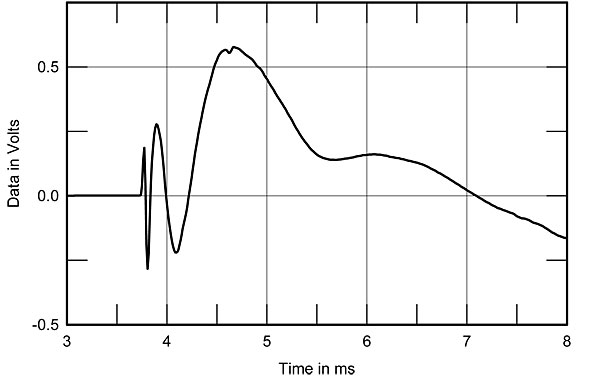
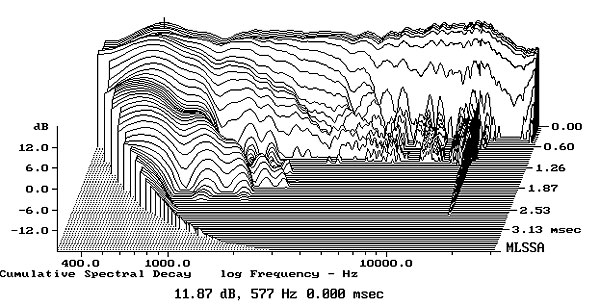
I think it fair to say that while the B1's use of spaced woofers produces anomalies in its measured anechoic or quasi-anechoic response—and does make optimal setup of the speakers more taxing than usual—it is possible to arrange things so as to get a fairly even lower-midrange balance.—John Atkinson

Bix would be flattered to know he has a transducer in his likeness!
http://www.outerspace-software.com/alphabix.html

Look at the 100 htz hump, Bose would be proud!

The rear firing 6.5" operates up to the 100Hz range. It is part of the design.